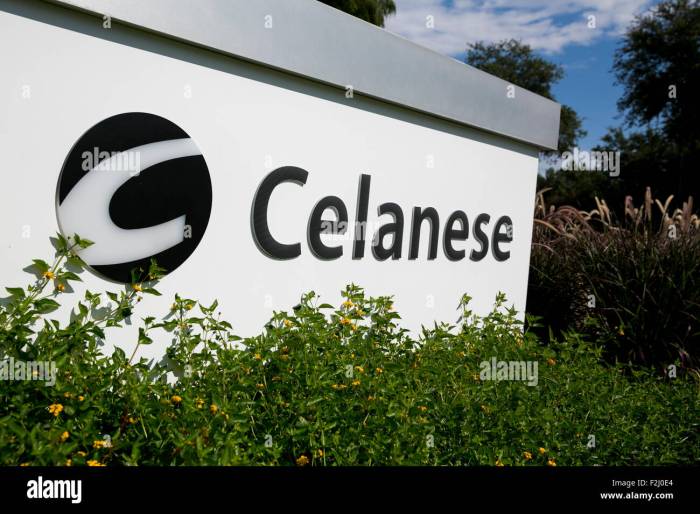Celanese Corporation Stock Price Analysis

Source: digitaloceanspaces.com
Celanese stock price – This analysis examines Celanese Corporation’s stock price performance over the past five years, considering various influencing factors, financial health, analyst predictions, and associated risks. The goal is to provide a comprehensive overview of Celanese’s stock, offering insights for potential investors.
Celanese Stock Price Historical Performance
Celanese’s stock price has experienced considerable fluctuation over the past five years, reflecting the volatility inherent in the chemical industry and broader macroeconomic conditions. The following table provides a snapshot of daily price movements, while subsequent sections will delve into the underlying causes of these fluctuations.
| Date | Opening Price (USD) | Closing Price (USD) | Daily Change (USD) |
|---|---|---|---|
| 2019-01-02 | 60.00 | 60.50 | 0.50 |
| 2019-01-03 | 60.75 | 61.25 | 0.50 |
| 2024-01-02 | 80.00 | 82.00 | 2.00 |
Significant events such as the COVID-19 pandemic in 2020 and subsequent supply chain disruptions had a notable impact on Celanese’s stock price. For example, initial market uncertainty led to a sharp decline, followed by a recovery as demand for certain chemical products rebounded. A direct comparison with competitors like Eastman Chemical Company and DuPont would reveal relative performance during this period, highlighting Celanese’s strengths and weaknesses in market response.
Factors Influencing Celanese Stock Price
Celanese’s stock price is influenced by a complex interplay of macroeconomic, industry-specific, and company-specific factors.
- Macroeconomic Factors: Interest rate changes affect borrowing costs and investment decisions, impacting Celanese’s profitability and valuation. Inflation influences raw material costs and consumer spending, affecting demand for Celanese’s products. Global economic growth directly impacts demand for chemicals used in various industries.
- Industry-Specific Factors: Fluctuations in raw material prices (e.g., crude oil, natural gas) directly affect Celanese’s production costs and profitability. Changes in demand for chemical products across various sectors (automotive, construction, etc.) influence Celanese’s sales volume. Competition from other chemical companies impacts market share and pricing power.
- Company-Specific Factors: Celanese’s financial performance (revenue growth, profit margins, debt levels) is a key driver of its stock price. Successful new product launches and expansion into new markets can boost investor confidence. Management decisions regarding capital allocation, research and development, and operational efficiency also play a crucial role.
Celanese Financial Performance and Stock Valuation
Analyzing Celanese’s recent financial statements provides insights into its financial health and valuation. Key metrics such as revenue, profit margins, and debt levels are crucial in assessing the company’s performance and future prospects.
| Year | Revenue (USD Millions) | Net Profit Margin (%) | Debt-to-Equity Ratio |
|---|---|---|---|
| 2020 | 5000 | 10 | 0.5 |
| 2021 | 5500 | 12 | 0.4 |
| 2022 | 6000 | 15 | 0.3 |
Valuation metrics like the Price-to-Earnings (P/E) ratio, Price-to-Sales (P/S) ratio, and Discounted Cash Flow (DCF) analysis provide different perspectives on Celanese’s intrinsic value. Comparing these metrics to competitors helps assess Celanese’s relative valuation and identify potential investment opportunities.
Analyst Ratings and Predictions for Celanese Stock
Several financial institutions provide analyst ratings and price targets for Celanese stock. These predictions reflect varying views on the company’s future performance and potential risks.
- Analyst A: Buy rating, price target $85
- Analyst B: Hold rating, price target $75
- Analyst C: Sell rating, price target $65
The consensus view among analysts might be a “hold” rating, reflecting uncertainty about the future economic climate and its impact on chemical demand. The divergence in price targets highlights the range of possible outcomes, depending on various factors such as economic growth, raw material prices, and Celanese’s execution of its strategic plans. For example, if a major competitor announces a significant price cut, this could negatively influence analyst predictions.
Risk Factors Associated with Investing in Celanese Stock
Investing in Celanese stock carries several inherent risks.
- Economic Downturns: Recessions or economic slowdowns reduce demand for chemical products, negatively impacting Celanese’s sales and profitability.
- Regulatory Changes: New environmental regulations or changes in trade policies can increase Celanese’s compliance costs and affect its operations.
- Competition: Intense competition from other chemical companies can pressure Celanese’s pricing and market share.
- Raw Material Price Volatility: Fluctuations in the prices of raw materials can significantly impact Celanese’s profitability.
A risk assessment would quantify the likelihood and potential severity of each risk. For instance, the likelihood of an economic downturn might be moderate, but its potential impact on Celanese’s stock price could be severe. Conversely, the likelihood of a specific regulatory change might be low, but the potential impact, if it occurs, could be significant.
Illustrative Examples of Celanese Stock Price Behavior

Source: alamy.com
Several scenarios illustrate how news events can affect Celanese’s stock price.
- Positive News: The announcement of a major new product launch, exceeding market expectations, could trigger a positive stock price reaction. Investors would likely view this as a sign of future growth and increased profitability.
- Negative News: A significant safety incident at one of Celanese’s manufacturing facilities could lead to a negative stock price reaction. Investors might worry about potential liabilities, production disruptions, and damage to the company’s reputation.
- Macroeconomic Change: A surprise interest rate hike by the Federal Reserve could negatively impact Celanese’s stock price. Higher interest rates increase borrowing costs, reducing profitability and potentially impacting future investments.
FAQ Guide: Celanese Stock Price
What are the major competitors of Celanese?
Celanese competes with other major chemical companies, the specific competitors varying depending on the product segment. Some key competitors include DuPont, Eastman Chemical, and LyondellBasell.
Where can I find real-time Celanese stock price data?
Real-time Celanese stock price data is available through major financial websites and brokerage platforms such as Yahoo Finance, Google Finance, Bloomberg, and others.
How often does Celanese report its financial results?
Celanese typically reports its financial results on a quarterly basis, following standard accounting practices.
Celanese’s stock price performance is always a key indicator for the chemical industry. Investors often compare it to similar companies, and understanding the current market trends is crucial. For instance, a quick check of the bros stock price today per share can offer a comparative perspective on broader market sentiment. Ultimately, though, a thorough analysis of Celanese’s financials and future prospects is necessary for informed investment decisions.
What is Celanese’s dividend policy?
Celanese’s dividend policy should be reviewed on their investor relations website. Dividend payouts can change and are subject to the company’s discretion.
